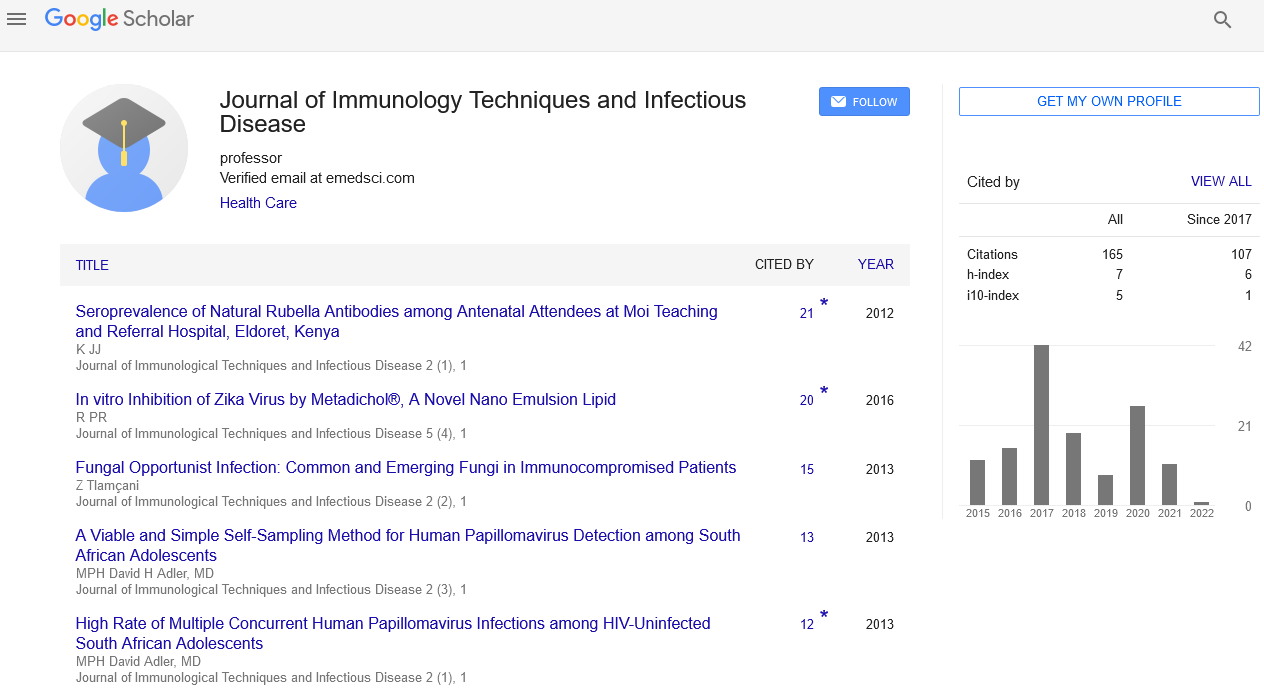Perspective, J Immunol Tech Infect Dis Vol: 12 Issue: 1
Intricate Process of Virus Invasion and Replication
Keung Jung*
Department of Pathology and Microbiology, University of Nebraska Medical Center, Nebraska, USA
*Corresponding Author: Keung Jung
Department of Pathology and Microbiology, University of Nebraska Medical Center, Nebraska, USA
E-mail: keungjung@gmail.com
Received date: 01-Feb-2023, Manuscript No. JIDIT-23-94484;
Editor assigned date: 03-Feb-2023, PreQC No. JIDIT-23-94484 (PQ);
Reviewed date: 17-Feb-2023, QC No. JIDIT-23-94484;
Revised date: 24-Feb-2023, Manuscript No. JIDIT-23-94484 (R);
Published date: 03-Mar-2023, DOI: 10.4172/2329-9541.1000338.
Citation: Jung K (2023) Intricate Process of Virus Invasion and Replication. J Immunol Tech Infect Dis 12:1.
Description
Viruses are tiny infectious agents that can cause a range of diseases in humans, animals, and plants. They are not considered living organisms as they cannot replicate on their own and require a host cell to multiply. The virus invasion and reproduction process is complex and intricate, including numerous processes that allow the virus to gain access to the body of the host and use it for its own purposes.
The first step in the invasion process is attachment. Viruses have surface proteins that allow them to attach to specific receptors on the surface of host cells. Once attached, the virus can enter the host cell through a variety of mechanisms, such as fusion with the host cell membrane or endocytosis. Once inside the host cell, the virus begins the process of replication. Viruses can have different replication strategies, but most involve the use of viral proteins to take over the host body cells and redirect it to produce more virus particles. This can involve the synthesis of viral RNA or DNA, the assembly of new virus particles, and the budding or release of new virus particles from the host cell.
Throughout the replication process, the virus must evade the host's immune system. Some viruses have developed mechanisms to evade detection by the immune system, such as hiding inside host cells or producing proteins that inhibit immune system function. A virus must replicate in order to produce new, infectious virions capable of infecting other cells in the body or later hosts. After entering the body, a virus interacts with and enters a target cell's plasma membrane. Within, it releases and duplicates its genome while boosting protein production by host ribosomes. These newly generated biological molecules are organised into virus particles, which then become infectious virions. Ultimately, the virions are expelled from the cell to continue the infection process.
The invasion and replication process of viruses can have serious consequences for the host. Depending on the type of virus and the host's immune response, infection can range from mild to severe, and can even be fatal. In addition, some viruses can cause long-term health problems, such as chronic infections or cancer. Virion release can occur via two methods: Lysis or budding- Lysis causes the death of an infected host cell; these viruses are known as cytolytic. Variola major, also known as smallpox, is an example. Enveloped viruses, such as influenza a virus, are often liberated from host cells through budding. This is the step that leads in the viral phospholipid envelope being acquired. These viruses, known as cytopathic viruses, do not normally kill the infected cell. Certain viral proteins persist within the host's cell membrane after virion release, acting as potential targets for circulating antibodies. Discarded viral proteins that remain in the host cell's cytoplasm can be processed and presented at the cell surface on MHC class-I molecules, where T lymphocytes recognise them.
Conclusion
Prevention and treatment of viral infections typically involve vaccines or antiviral drugs. Vaccines work by stimulating the immune system to produce antibodies against specific viruses, while antiviral drugs target different stages of the viral replication process to prevent or slow down virus multiplication. The invasion and replication process of viruses is a complex and intricate one that allows viruses to take over host cells and use them to multiply the mechanisms of virus invasion and replication is essential for the development of effective prevention and treatment strategies for viral infections.
 Spanish
Spanish  Chinese
Chinese  Russian
Russian  German
German  French
French  Japanese
Japanese  Portuguese
Portuguese  Hindi
Hindi 
